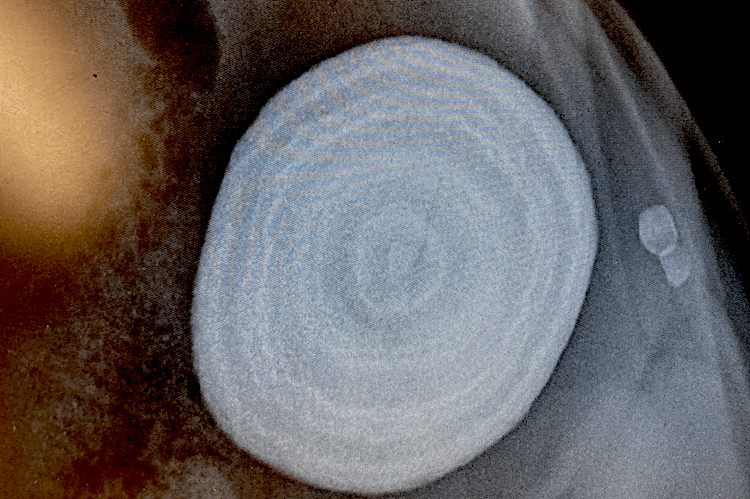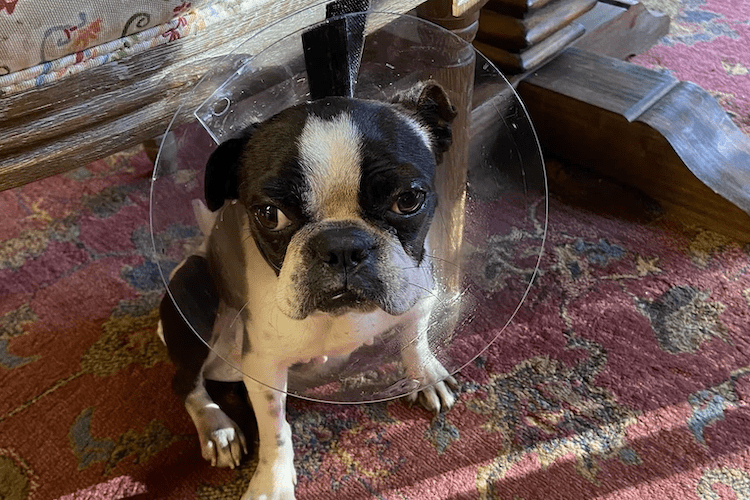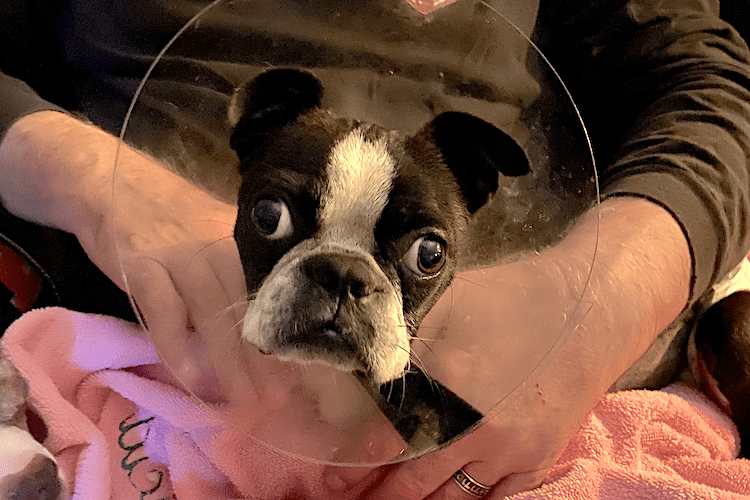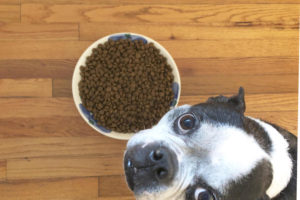Even though I am currently not an active administrator with an animal rescue organization, every now and then, I get calls to help a dog. Lately, I’ve gotten a lot of calls! This week, I received a call to help a sweet Boston terrier that’d developed rectal prolapse.
I’m grateful to have my resources still available – I couldn’t help without them.
This little dog’s owner was frantic; the vet couldn’t replace the everted tissue. The owner couldn’t afford the rectal prolapse repair surgery cost as quoted by her vet, and the vet recommended euthanasia. She called me – confused, unsure of what to do, and wanted advice.
The dog is fine. The rectal prolapse was surgically corrected, and we were able to determine the probable cause of the rectal prolapse. The prognosis is good.
Disclaimer:
I am not a veterinarian nor an animal behaviorist. I present my understanding of health or behavior issues based on personal experience, courses, and readings. If you have a dog with a health or behavioral issue, seek professional guidance. I hope you find my post useful.
(I included the full story on this pup at the end of this post)
Is Rectal Prolapse In Dogs an Emergency?
Rectal Prolapse is not a death sentence, but it is an emergency. There are treatment options for rectal prolapse.
If you believe your foster dog has a rectal prolapse right now, contact a veterinary professional for instructions. Do not wait for the issue to resolve itself! You put your dog at risk of lifelong issues if you do.
Rectal Prolapse: Prevalence and Implications for Dog Rescue Work
If you participate in dog rescue for any length of time, you WILL see a rectal prolapse and you need to know what to do.
According to D. E. Johnson, (citation: Johnston, D. E. (1985). Surgical diseases-rectum and anus. In slatter 3rd ed. Text Book of Small Animal Surgery. W. B. Saunders, Philadelphia, pp 770-794) the prevalence is highest in young, “unthrifty” dogs with intestinal parasites and severe diarrhea.
In rescue, we get a lot of wormy puppies with severe diarrhea, right?
What Is A Rectal Prolapse?
Rectal prolapse is when layers of the rectum – the last part of the large intestines – turn inside out and protrude through the anus.
It looks like tubular-shaped tissue, red or pink in color. It may appear bloody, crusty, it may ooze, and the tissue can begin to turn a dark color. When the tissue remains outside of the body, it can begin to die. (become necrotic)
Rectal prolapse commonly occurs in young dogs that have severe diarrhea or that routinely strain to defecate.
Complete Rectal Prolapse In Dogs
All of the layers protrude through the anus
Incomplete Rectal Prolapse In Dogs
Only the innermost rectal layer protrudes from the anal opening. Sometimes, you can even see an incomplete rectal prolapse in dogs while they are defecating! The tissue returns to its normal position after the dog has finished pooping. If you think this is happening, do talk with your veterinarian – my thought is that a recurrent incomplete rectal prolapse can turn into a complete rectal prolapse at any time.
Images of Rectal Prolapse In Dogs
I’m not going to post pictures of a dog’s rectal prolapse – first of all, the photos aren’t mine but if you want to know what a rectal prolapse looks like, (and you should) simply type in “image rectal prolapse dogs” in the search bar of your favorite search engine and you’ll see plenty of photos.
What A Rectal Prolapse Isn’t
Rectal prolapse in dogs is not the same thing as hemorrhoids. Hemorrhoids are inflamed veins. Dogs do not get or suffer from hemorrhoids.
Rectal prolapse in dogs is also not solid evidence that the dog has been subjected to sexual abuse. There are many reasons a dog may develop rectal prolapse. A veterinarian knows what to look for and can find the underlying reason for the development of the rectal prolapse.
Is Rectal Prolapse in Dogs Fatal?
Yes. If the dog does not receive care at a veterinary clinic, intestinal tissue will die causing infection, sepsis, and death.
How To Treat Rectal Prolapse In Dogs At Home
Contact your veterinarian! If you have the means, send them a photo. Get in the car and take your dog to the clinic or the ER vet clinic ASAP. While enroute, keep the tissue clean and moist using saline solution or water-soluble lubricating jelly.
Do not try and push the tissue back in yourself. You can create intussusception, (part of the intestine slides into an adjacent part of the intestine) a life-threatening condition. Please let the veterinarian handle putting the rectal tissue back into place.
The only home care you should do for rectal prolapse in a dog is – make sure you keep the tissue moist and get the dog to the vet quickly.
What Causes Rectal Prolapse In Dogs?
Honestly, veterinarians don’t really know why rectal prolapse happens, but they do know that rectal prolapse is caused by a number of different conditions or nerve damage. I found no information suggesting that rectal prolapse is hereditary.
Generally, a rectal prolapse happens due to frequent straining. (to poop, urinate, give birth) Often the dog simply feels the urge to (tenesmus) but has no matter to move. (as in the case of severe diarrhea)
Frequent straining is thought to possibly weaken the structures that hold the rectum in place.
Broadly, causes can be:
- Severe inflammation of intestines (enteritis or colitis)
- Intestinal parasites
- disorders of the rectum (eg, foreign bodies, lacerations, diverticula, or sacculation)
- Neoplasia (mass) of the rectum or distal colon
- Urolithiasis (bladder stones)
- urethral obstruction
- Inflammation of the bladder, usually due to bladder infection
- Difficult whelping
- prostatic disease
- Perianal hernia
Diagnosing Rectal Prolapse In Dogs
The very first thing your vet will do is a physical exam. They are going to perform a rectal exam to look at the prolapsed tissue and investigate further to determine the best treatment course.
They will do a fecal exam, most likely to investigate the presence of intestinal worms.
They may do an x-ray or ultrasound. The dog above had an x-ray and this is what was revealed:

Treatments for Rectal Prolapse
Depending upon your veterinarian’s findings, they may try to put viable rectal tissue back in place after cleaning the tissue thoroughly and lubricating the tissue very well. If the tissue is swollen, they may apply or administer medication to shrink the tissue. Sedation or anesthesia may be needed. A rectal prolapse in dogs can be painful and can become necrotic quickly.
After the tissue is back in place, the vet will probably perform a “purse-string” suture (think drawstring bag) around the anus to keep the opening small and prevent the rectum from prolapsing again. This suture will remain in place for 5-7 days while the pet heals.
An e-collar will be necessary to help keep your dog from licking at the area, both before treatment and afterward.
A purse-string suture is also a temporary measure until the dog can undergo surgery for a more permanent correction.
Disclosure: This post contains affiliate links. As an affiliate, I earn a commission on qualifying purchases made through these links, at no additional cost to you. I only recommend products I use and love or plan to purchase myself.
Surgical Treatments For Rectal Prolapse
It is not uncommon for a rectal prolapse to require surgery. While some prolapses heal with replacement and purse-string suture treatment, others do require more advanced surgical procedures:
- Colopexy – when the rectum is tacked to the body wall from inside the abdomen. This helps keep the rectum in place and prevents further prolapse.
- Resection and anastomosis – This is when tissue is too damaged to be placed back in the body and needs to be removed. The section of damaged tissue is removed and the remaining intestines are joined together.
Rectal Prolapse Surgery Cost for Dogs
Costs will vary based on diagnostic workup and the surgical procedure necessary to restore functioning.
Your dog might do fine with a simple fecal exam and a purse-string suture procedure, done by a general practice veterinarian. If your dog requires bloodwork, x-rays, and a more invasive surgical repair like a colopexy or resection procedure, your general practice vet may refer you to a board-certified surgical specialist.
Post Surgery Care for Rectal Prolapse In Dogs
Your dog will be sent home with an e-collar, I can promise you that! Your dog doesn’t need access to its anus while healing. Allowing your dog to lick their surgical sites will put sutures at risk of failing and I really don’t need to tell you that the surgical site can get really infected.
How to Help Your Dog Adjust To Wearing An Elizabethan Collar
Also, in order to allow the tissue to heal, your vet may prescribe soft food and stool softeners for the near future. This will help in the formation of smaller, softer stool and allow for easy passing of stool.
If antibiotics and/or pain medications are prescribed, please talk with your veterinarian about the side effects of those medications and supportive care indicated. (Probiotics, for example)
If your dog is placed on activity restriction, please adhere to those recommendations. Restrict the dog’s space (no more than 3’ x 4’ space, for example) and use leash walking only for potty breaks. If your dog is having a hard time with the confinement, ask your veterinarian about medications to help keep your dog calm and relaxed.
If diarrhea develops or continues after surgery, reach out to the vet for further care as diarrhea can cause complications and infection, not to mention cause straining.
Recurrence of Rectal Prolapse
A vet may choose to treat with a purse-string procedure first to see if this less-invasive surgical procedure will work. If it fails (the rectal prolapse returns) then the vet may consider a colopexy to secure the rectal tissue in place. My surgeons usually opt for the colopexy as a preventive measure, but the cost is obviously greater.
The Little Dog with The Rectal Prolapse

Little, one-year-old “Z” was in a trial adoption home arranged by a private owner. Best we know, “Z” developed a prolapsed rectum sometime the evening before. “Z’s” owner learned of the prolapse that next morning, retrieved her, and took her to the vet.
There, the vet attempted to replace the prolapsed tissue but could not and advised surgery. Cost being prohibitive, the vet then recommended euthanasia. The owner called me.
I assured her that “Z” did not need to be euthanized (yet) and that I knew of a rescue that could help. Because the owner already was wanting to rehome this dog, I suggested that she surrender the dog to rescue so we could quickly help. She agreed.
(I don’t always ask for a dog to be surrendered in order for medical help to be provided, but in this case, it was the correct call.)
The owner was already providing good care to the rectal tissue: keeping the tissue clean and moist with saline solution. She sent me a photo: the prolapse was bad, but I’d seen worse.
Transport arranged, “Z” arrived through the emergency vet at the Specialty Surgical Center 5 hours away.
By the time she arrived, tissue was already turning dark on one side of the prolapse. I’d guess the tissue had been out of the body for about 24 hours at this point.
The emergency vet was able to replace the prolapsed rectum and secure it in place with a purse string suture to keep the anal opening small and help keep the rectum from prolapsing again.
I already knew about “Z’s” history of bladder stones and I shared this information with those taking over her care. The ER team did an abdominal x-ray and sure enough – there was a huge bladder stone that nearly filled up her entire bladder. The bladder stone showed repeated bladder infections over the course of her young life.
She’d been straining to urinate.
“Z” would have a second surgery the very next morning.
During that surgery, the specialty surgeon did the following procedures:
- Corrected an intestinal intussusception – the tissue had folded on itself and the surgeon straightened the tissue out.
- Performed a colopexy – he attached the rectum to the body wall to prevent it from prolapsing again
- Performed a cystotomy to remove the large bladder stone and several smaller ones
- Performed an elective spay
“Z” was discharged from the surgery center the next day.
Her aftercare was as follows:
Strict exercise restrictions – due to the multiple surgeries performed on her. “Z” would need to be confined to a small space for 2 weeks with only leash walks for potty breaks. No running, jumping, free play, free walking around, swimming, or bathing.
Sedatives were provided to help keep her calm if needed.
Diet: normal.
E-collar on at all times.
“Z” was prescribed 2 different antibiotics (both for urinary tract issues and GI inflammation – maybe the latter to prevent diarrhea?), pain medications, a dewormer, and an anti-inflammatory medication.
She was not prescribed a stool softener.
She was scheduled for follow-up in two weeks for urinary tract care.
Pre-surgical bloodwork (complete cbc/chemistry profile) was significant:
She has evidence of chronic inflammation based on certain lab values.
She is heartworm positive.
In summary, rectal prolapse in dogs is a serious condition requiring immediate veterinary intervention for optimal success. Almost always there is an underlying condition that influences the development of the rectal prolapse that will also need treatment. Those who participate in dog rescue work probably see a higher incidence of rectal prolapse and should be aware of the proper care required and the need to get the dog immediate professional veterinary care.




